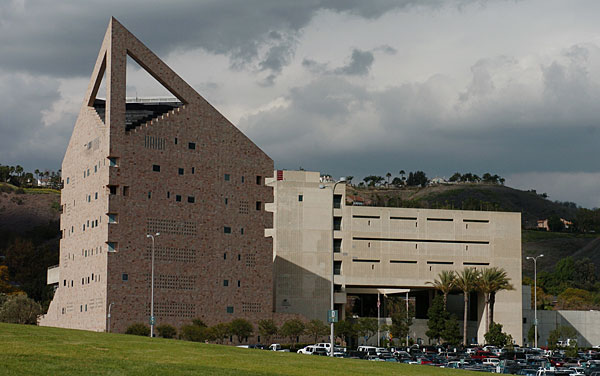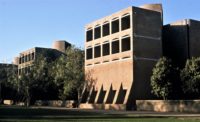 |
| Photo © Tom Zasadzinski/Cal Poly Pomona |
The CLA complex includes the iconic eight-story structure and a connected seven-story classroom building. Both may be demolished. |

Antoine Predock’s futuristic Classroom Laboratory Administration (CLA) Building, on the campus of Cal Poly Pomona, is only 17 years old, but it may be headed for demolition.
University officials say the triangular structure, known on campus as the “pointy building,” needs extensive repairs and seismic upgrades that could cost as much as $80 million. University President Michael Ortiz, in an e-mail message sent to students, faculty, and staff members on September 15, said it makes more fiscal sense to replace the building with a brand-new facility in a different location. And on September 21, the California State University Board of Trustees approved a proposal to construct a new building.
Still, university officials emphasize that no final decision has been made. While they initially suggested Predock’s building would be demolished, they recently announced they will hire a consultant to study whether any portion of it can be preserved. “The wrecking ball is not imminent,” says Mike Sylvester, the university’s associate vice president for facilities, planning, and management. “Even if we made a decision today to demolish the building, it won’t happen for at least another five years.” Sylvester added: “What we’re trying to do is soften the discussion of demolition.”
Completed in 1993, the CLA complex (which includes both the triangular tower and a more conventional building for classes and laboratories) is the most recognizable structure on the Cal Poly Pomona campus, clearly visible from the nearby 10 Freeway. The eight-story tower has been used as a backdrop in several Hollywood science fiction movies, including Gattica and Impostor, as well as numerous car commercials. It’s even part of the university’s official logo.
Albuquerque-based Predock, recipient of the 2006 AIA Gold Medal, won an international competition to design the building, which cost about $24 million to construct. But Cal Poly officials say the building has numerous structural flaws, most notably water intrusion, which resulted in a lawsuit filed against a contractor. (The university won a $13.3 million out-of-court settlement in 2005.) It also sits atop the San Jose Fault. Any major repairs to the CLA would require that it brought up to current building codes, including ADA requirements and California safety earthquake standards. During construction, the building’s approximately 400 employees would have to be relocated, an additional expense.
Despite its iconic status, the building gets mixed reviews for its design. Ortiz, in his September 15 e-mail, called the CLA “difficult to navigate,” with wasted internal space and energy inefficiencies. Sylvester adds, “It’s an extremely difficult building to use because of its triangular spaces.” Judith Sheine, chair of the university’s school of architecture, agrees that the triangular floor plan presents some “challenges” for users, but she praises the building for the dramatic statement it makes. “It’s important for the image of the campus,” she says.
Predock did not respond to messages left with his office. Sylvester says the architect’s stature will be considered as the future of the CLA Building is studied.



Post a comment to this article
Report Abusive Comment